Eastern Institute of Technology: Advanced Operations Management Report
VerifiedAdded on 2023/06/11
|7
|1564
|396
Report
AI Summary
This report analyzes key concepts in advanced operations management, addressing the bullwhip effect and supply chain risks. It explores the causes and effects of the bullwhip effect, including demand forecasting, order batching, and price fluctuations, and suggests collaborative strategies and improved forecasting for mitigation. The report also categorizes purchasing and supply risks, such as supply disruptions, delays, and forecast inaccuracies, and examines how Ezibuy manages its supply chain risks through supplier profiling, vulnerability assessments, and mitigation strategies. The report provides a comprehensive overview of supply chain management challenges and potential solutions, drawing on academic research and practical examples.

qwertyuiopasdfghjklzxcvbnmqw
ertyuiopasdfghjklzxcvbnmqwert
yuiopasdfghjklzxcvbnmqwertyui
opasdfghjklzxcvbnmqwertyuiop
asdfghjklzxcvbnmqwertyuiopasd
fghjklzxcvbnmqwertyuiopasdfgh
jklzxcvbnmqwertyuiopasdfghjkl
zxcvbnmqwertyuiopasdfghjklzxc
vbnmqwertyuiopasdfghjklzxcvb
nmqwertyuiopasdfghjklzxcvbnm
qwertyuiopasdfghjklzxcvbnmqw
ertyuiopasdfghjklzxcvbnmqwert
yuiopasdfghjklzxcvbnmqwertyui
opasdfghjklzxcvbnmqwertyuiop
asdfghjklzxcvbnmqwertyuiopasd
fghjklzxcvbnmqwertyuiopasdfgh
jklzxcvbnmrtyuiopasdfghjklzxcv
bnmqwertyuiopasdfghjklzxcvbn
mqwertyuiopasdfghjklzxcvbnmq
wertyuiopasdfghjklzxcvbnmqwe
Advanced Operations Management
Report
6/21/2018
Student Name
ertyuiopasdfghjklzxcvbnmqwert
yuiopasdfghjklzxcvbnmqwertyui
opasdfghjklzxcvbnmqwertyuiop
asdfghjklzxcvbnmqwertyuiopasd
fghjklzxcvbnmqwertyuiopasdfgh
jklzxcvbnmqwertyuiopasdfghjkl
zxcvbnmqwertyuiopasdfghjklzxc
vbnmqwertyuiopasdfghjklzxcvb
nmqwertyuiopasdfghjklzxcvbnm
qwertyuiopasdfghjklzxcvbnmqw
ertyuiopasdfghjklzxcvbnmqwert
yuiopasdfghjklzxcvbnmqwertyui
opasdfghjklzxcvbnmqwertyuiop
asdfghjklzxcvbnmqwertyuiopasd
fghjklzxcvbnmqwertyuiopasdfgh
jklzxcvbnmrtyuiopasdfghjklzxcv
bnmqwertyuiopasdfghjklzxcvbn
mqwertyuiopasdfghjklzxcvbnmq
wertyuiopasdfghjklzxcvbnmqwe
Advanced Operations Management
Report
6/21/2018
Student Name
Paraphrase This Document
Need a fresh take? Get an instant paraphrase of this document with our AI Paraphraser
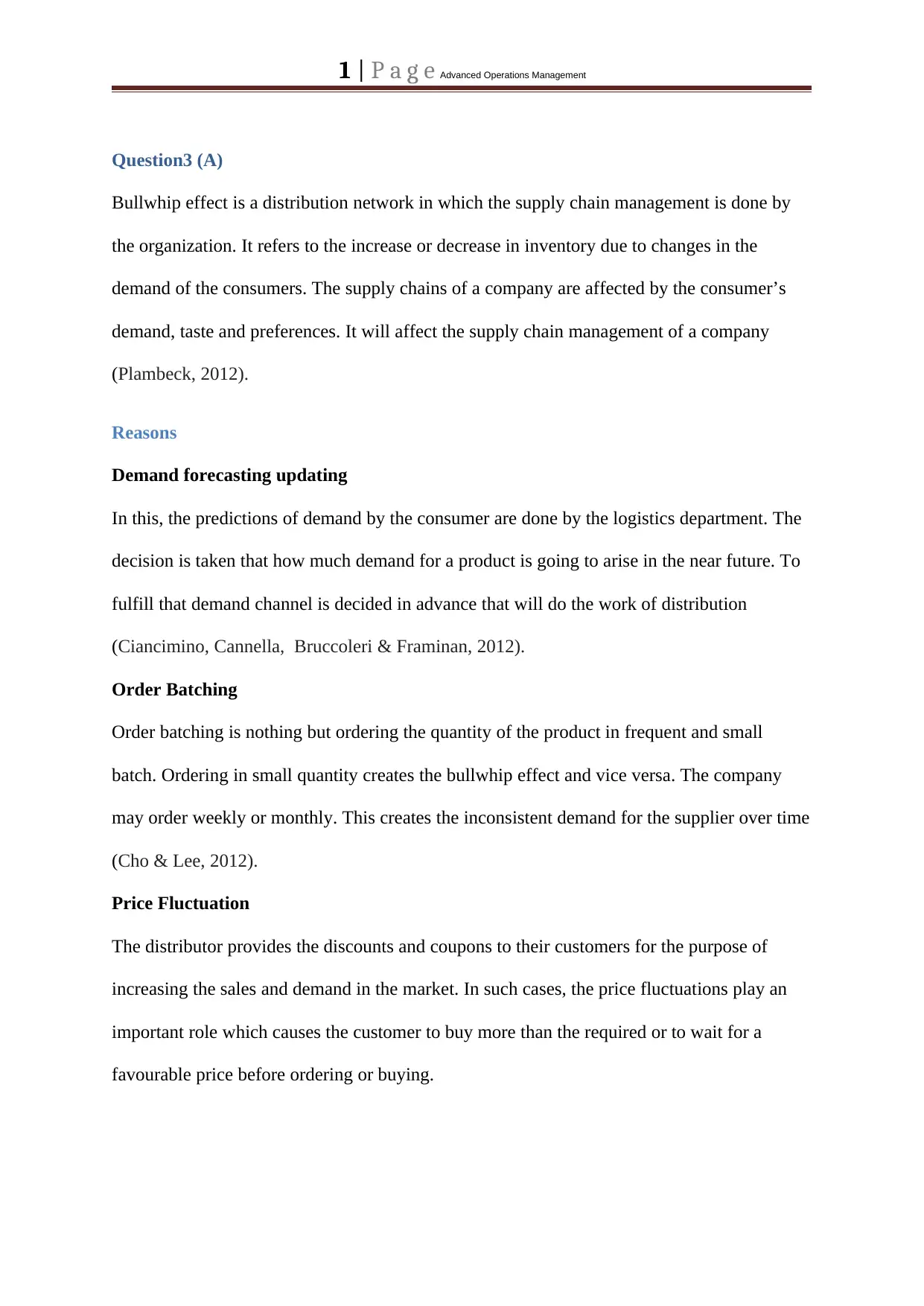
1 | P a g e Advanced Operations Management
Question3 (A)
Bullwhip effect is a distribution network in which the supply chain management is done by
the organization. It refers to the increase or decrease in inventory due to changes in the
demand of the consumers. The supply chains of a company are affected by the consumer’s
demand, taste and preferences. It will affect the supply chain management of a company
(Plambeck, 2012).
Reasons
Demand forecasting updating
In this, the predictions of demand by the consumer are done by the logistics department. The
decision is taken that how much demand for a product is going to arise in the near future. To
fulfill that demand channel is decided in advance that will do the work of distribution
(Ciancimino, Cannella, Bruccoleri & Framinan, 2012).
Order Batching
Order batching is nothing but ordering the quantity of the product in frequent and small
batch. Ordering in small quantity creates the bullwhip effect and vice versa. The company
may order weekly or monthly. This creates the inconsistent demand for the supplier over time
(Cho & Lee, 2012).
Price Fluctuation
The distributor provides the discounts and coupons to their customers for the purpose of
increasing the sales and demand in the market. In such cases, the price fluctuations play an
important role which causes the customer to buy more than the required or to wait for a
favourable price before ordering or buying.
Question3 (A)
Bullwhip effect is a distribution network in which the supply chain management is done by
the organization. It refers to the increase or decrease in inventory due to changes in the
demand of the consumers. The supply chains of a company are affected by the consumer’s
demand, taste and preferences. It will affect the supply chain management of a company
(Plambeck, 2012).
Reasons
Demand forecasting updating
In this, the predictions of demand by the consumer are done by the logistics department. The
decision is taken that how much demand for a product is going to arise in the near future. To
fulfill that demand channel is decided in advance that will do the work of distribution
(Ciancimino, Cannella, Bruccoleri & Framinan, 2012).
Order Batching
Order batching is nothing but ordering the quantity of the product in frequent and small
batch. Ordering in small quantity creates the bullwhip effect and vice versa. The company
may order weekly or monthly. This creates the inconsistent demand for the supplier over time
(Cho & Lee, 2012).
Price Fluctuation
The distributor provides the discounts and coupons to their customers for the purpose of
increasing the sales and demand in the market. In such cases, the price fluctuations play an
important role which causes the customer to buy more than the required or to wait for a
favourable price before ordering or buying.
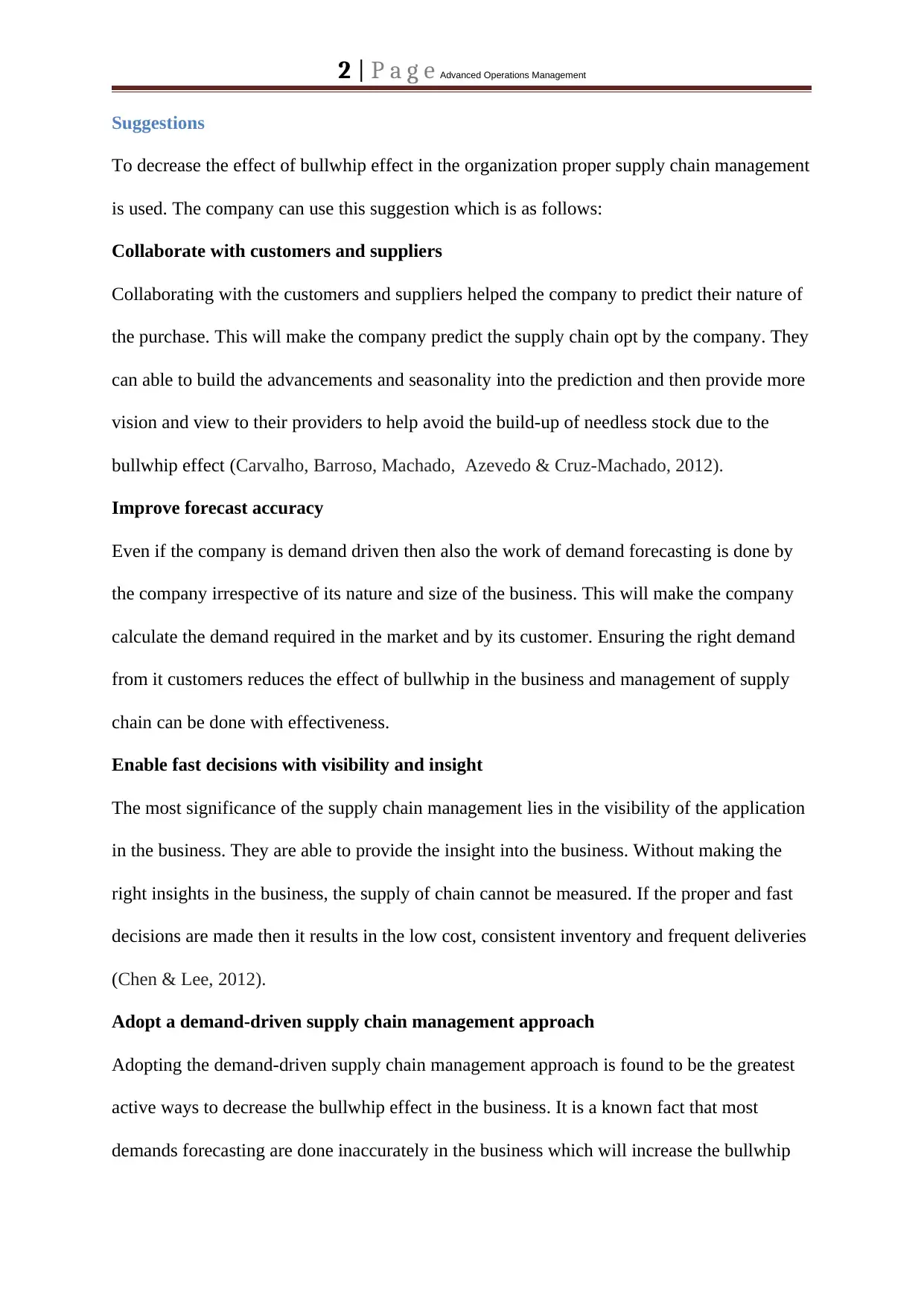
2 | P a g e Advanced Operations Management
Suggestions
To decrease the effect of bullwhip effect in the organization proper supply chain management
is used. The company can use this suggestion which is as follows:
Collaborate with customers and suppliers
Collaborating with the customers and suppliers helped the company to predict their nature of
the purchase. This will make the company predict the supply chain opt by the company. They
can able to build the advancements and seasonality into the prediction and then provide more
vision and view to their providers to help avoid the build-up of needless stock due to the
bullwhip effect (Carvalho, Barroso, Machado, Azevedo & Cruz-Machado, 2012).
Improve forecast accuracy
Even if the company is demand driven then also the work of demand forecasting is done by
the company irrespective of its nature and size of the business. This will make the company
calculate the demand required in the market and by its customer. Ensuring the right demand
from it customers reduces the effect of bullwhip in the business and management of supply
chain can be done with effectiveness.
Enable fast decisions with visibility and insight
The most significance of the supply chain management lies in the visibility of the application
in the business. They are able to provide the insight into the business. Without making the
right insights in the business, the supply of chain cannot be measured. If the proper and fast
decisions are made then it results in the low cost, consistent inventory and frequent deliveries
(Chen & Lee, 2012).
Adopt a demand-driven supply chain management approach
Adopting the demand-driven supply chain management approach is found to be the greatest
active ways to decrease the bullwhip effect in the business. It is a known fact that most
demands forecasting are done inaccurately in the business which will increase the bullwhip
Suggestions
To decrease the effect of bullwhip effect in the organization proper supply chain management
is used. The company can use this suggestion which is as follows:
Collaborate with customers and suppliers
Collaborating with the customers and suppliers helped the company to predict their nature of
the purchase. This will make the company predict the supply chain opt by the company. They
can able to build the advancements and seasonality into the prediction and then provide more
vision and view to their providers to help avoid the build-up of needless stock due to the
bullwhip effect (Carvalho, Barroso, Machado, Azevedo & Cruz-Machado, 2012).
Improve forecast accuracy
Even if the company is demand driven then also the work of demand forecasting is done by
the company irrespective of its nature and size of the business. This will make the company
calculate the demand required in the market and by its customer. Ensuring the right demand
from it customers reduces the effect of bullwhip in the business and management of supply
chain can be done with effectiveness.
Enable fast decisions with visibility and insight
The most significance of the supply chain management lies in the visibility of the application
in the business. They are able to provide the insight into the business. Without making the
right insights in the business, the supply of chain cannot be measured. If the proper and fast
decisions are made then it results in the low cost, consistent inventory and frequent deliveries
(Chen & Lee, 2012).
Adopt a demand-driven supply chain management approach
Adopting the demand-driven supply chain management approach is found to be the greatest
active ways to decrease the bullwhip effect in the business. It is a known fact that most
demands forecasting are done inaccurately in the business which will increase the bullwhip
⊘ This is a preview!⊘
Do you want full access?
Subscribe today to unlock all pages.

Trusted by 1+ million students worldwide
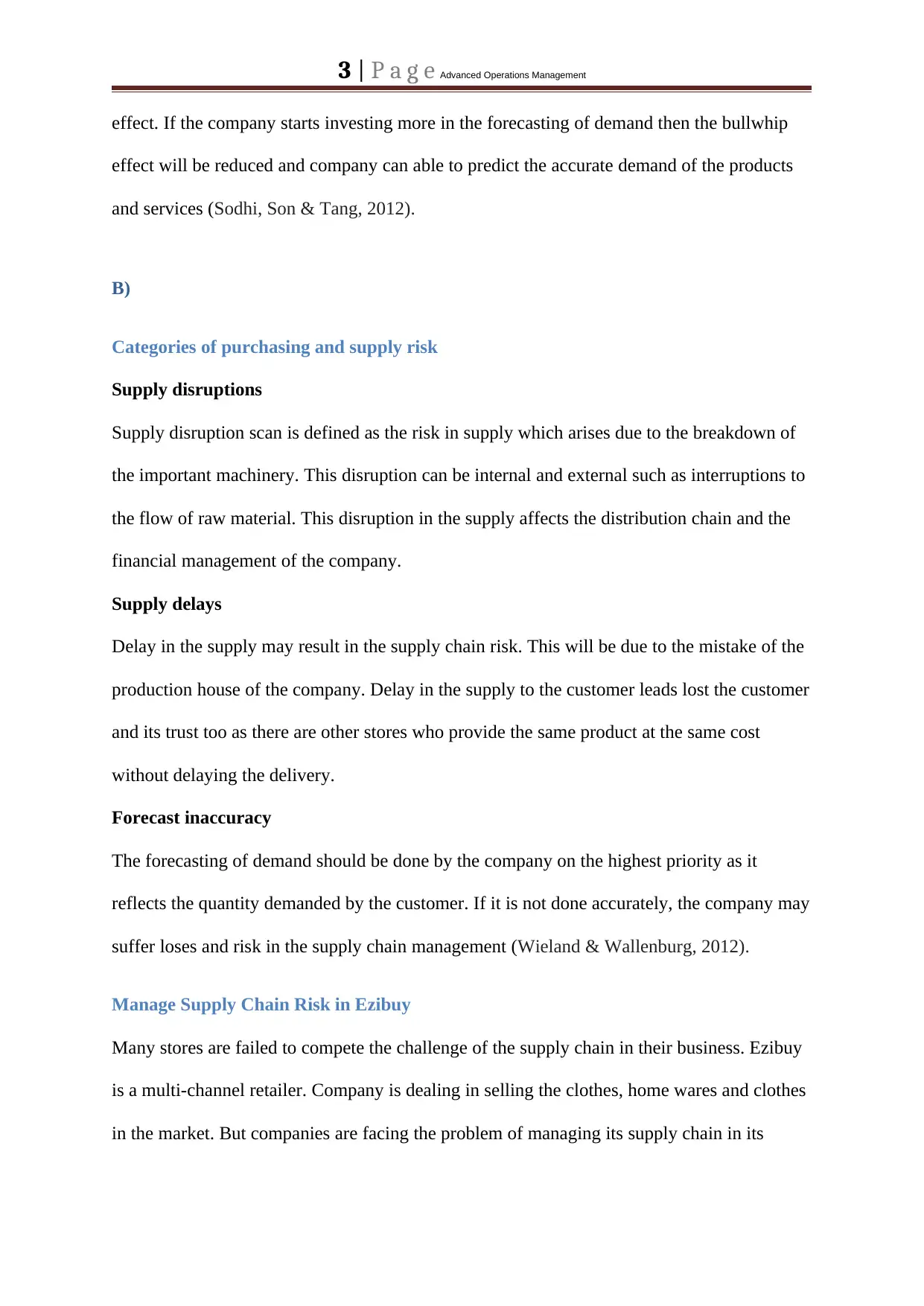
3 | P a g e Advanced Operations Management
effect. If the company starts investing more in the forecasting of demand then the bullwhip
effect will be reduced and company can able to predict the accurate demand of the products
and services (Sodhi, Son & Tang, 2012).
B)
Categories of purchasing and supply risk
Supply disruptions
Supply disruption scan is defined as the risk in supply which arises due to the breakdown of
the important machinery. This disruption can be internal and external such as interruptions to
the flow of raw material. This disruption in the supply affects the distribution chain and the
financial management of the company.
Supply delays
Delay in the supply may result in the supply chain risk. This will be due to the mistake of the
production house of the company. Delay in the supply to the customer leads lost the customer
and its trust too as there are other stores who provide the same product at the same cost
without delaying the delivery.
Forecast inaccuracy
The forecasting of demand should be done by the company on the highest priority as it
reflects the quantity demanded by the customer. If it is not done accurately, the company may
suffer loses and risk in the supply chain management (Wieland & Wallenburg, 2012).
Manage Supply Chain Risk in Ezibuy
Many stores are failed to compete the challenge of the supply chain in their business. Ezibuy
is a multi-channel retailer. Company is dealing in selling the clothes, home wares and clothes
in the market. But companies are facing the problem of managing its supply chain in its
effect. If the company starts investing more in the forecasting of demand then the bullwhip
effect will be reduced and company can able to predict the accurate demand of the products
and services (Sodhi, Son & Tang, 2012).
B)
Categories of purchasing and supply risk
Supply disruptions
Supply disruption scan is defined as the risk in supply which arises due to the breakdown of
the important machinery. This disruption can be internal and external such as interruptions to
the flow of raw material. This disruption in the supply affects the distribution chain and the
financial management of the company.
Supply delays
Delay in the supply may result in the supply chain risk. This will be due to the mistake of the
production house of the company. Delay in the supply to the customer leads lost the customer
and its trust too as there are other stores who provide the same product at the same cost
without delaying the delivery.
Forecast inaccuracy
The forecasting of demand should be done by the company on the highest priority as it
reflects the quantity demanded by the customer. If it is not done accurately, the company may
suffer loses and risk in the supply chain management (Wieland & Wallenburg, 2012).
Manage Supply Chain Risk in Ezibuy
Many stores are failed to compete the challenge of the supply chain in their business. Ezibuy
is a multi-channel retailer. Company is dealing in selling the clothes, home wares and clothes
in the market. But companies are facing the problem of managing its supply chain in its
Paraphrase This Document
Need a fresh take? Get an instant paraphrase of this document with our AI Paraphraser
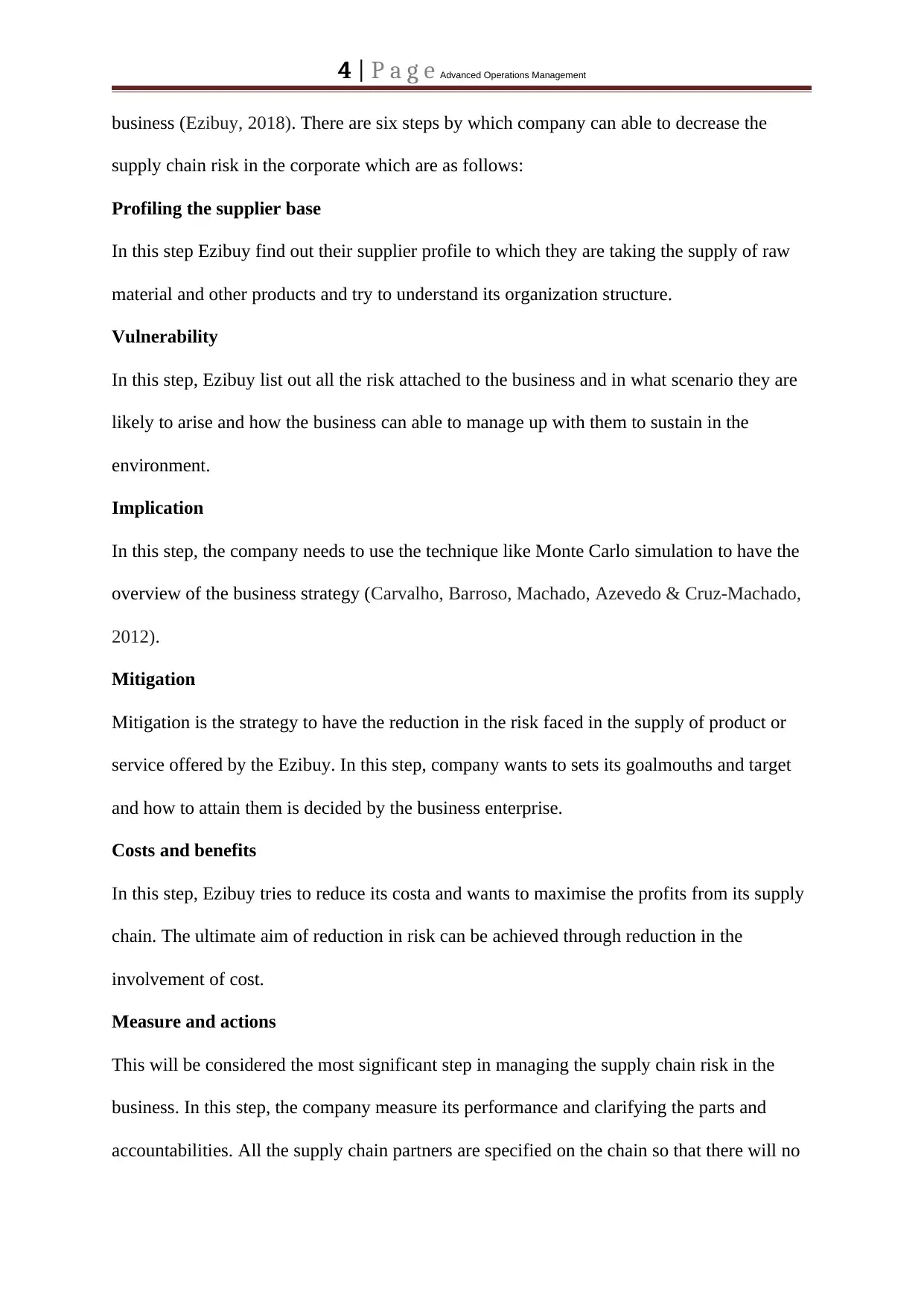
4 | P a g e Advanced Operations Management
business (Ezibuy, 2018). There are six steps by which company can able to decrease the
supply chain risk in the corporate which are as follows:
Profiling the supplier base
In this step Ezibuy find out their supplier profile to which they are taking the supply of raw
material and other products and try to understand its organization structure.
Vulnerability
In this step, Ezibuy list out all the risk attached to the business and in what scenario they are
likely to arise and how the business can able to manage up with them to sustain in the
environment.
Implication
In this step, the company needs to use the technique like Monte Carlo simulation to have the
overview of the business strategy (Carvalho, Barroso, Machado, Azevedo & Cruz-Machado,
2012).
Mitigation
Mitigation is the strategy to have the reduction in the risk faced in the supply of product or
service offered by the Ezibuy. In this step, company wants to sets its goalmouths and target
and how to attain them is decided by the business enterprise.
Costs and benefits
In this step, Ezibuy tries to reduce its costa and wants to maximise the profits from its supply
chain. The ultimate aim of reduction in risk can be achieved through reduction in the
involvement of cost.
Measure and actions
This will be considered the most significant step in managing the supply chain risk in the
business. In this step, the company measure its performance and clarifying the parts and
accountabilities. All the supply chain partners are specified on the chain so that there will no
business (Ezibuy, 2018). There are six steps by which company can able to decrease the
supply chain risk in the corporate which are as follows:
Profiling the supplier base
In this step Ezibuy find out their supplier profile to which they are taking the supply of raw
material and other products and try to understand its organization structure.
Vulnerability
In this step, Ezibuy list out all the risk attached to the business and in what scenario they are
likely to arise and how the business can able to manage up with them to sustain in the
environment.
Implication
In this step, the company needs to use the technique like Monte Carlo simulation to have the
overview of the business strategy (Carvalho, Barroso, Machado, Azevedo & Cruz-Machado,
2012).
Mitigation
Mitigation is the strategy to have the reduction in the risk faced in the supply of product or
service offered by the Ezibuy. In this step, company wants to sets its goalmouths and target
and how to attain them is decided by the business enterprise.
Costs and benefits
In this step, Ezibuy tries to reduce its costa and wants to maximise the profits from its supply
chain. The ultimate aim of reduction in risk can be achieved through reduction in the
involvement of cost.
Measure and actions
This will be considered the most significant step in managing the supply chain risk in the
business. In this step, the company measure its performance and clarifying the parts and
accountabilities. All the supply chain partners are specified on the chain so that there will no

5 | P a g e Advanced Operations Management
misunderstanding at the time of implementation (Lavastre, Gunasekaran & Spalanzani,
2012).
misunderstanding at the time of implementation (Lavastre, Gunasekaran & Spalanzani,
2012).
⊘ This is a preview!⊘
Do you want full access?
Subscribe today to unlock all pages.

Trusted by 1+ million students worldwide
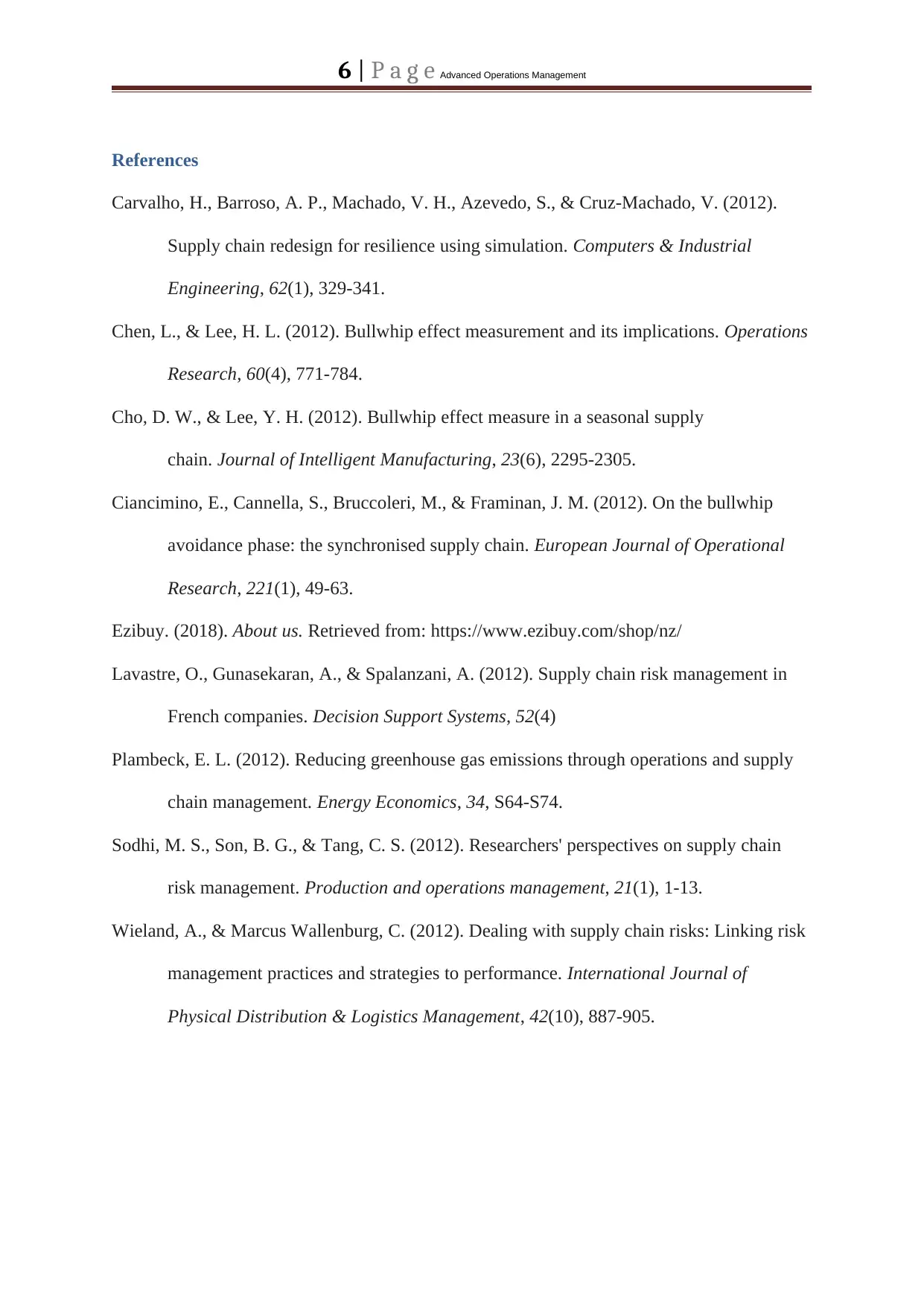
6 | P a g e Advanced Operations Management
References
Carvalho, H., Barroso, A. P., Machado, V. H., Azevedo, S., & Cruz-Machado, V. (2012).
Supply chain redesign for resilience using simulation. Computers & Industrial
Engineering, 62(1), 329-341.
Chen, L., & Lee, H. L. (2012). Bullwhip effect measurement and its implications. Operations
Research, 60(4), 771-784.
Cho, D. W., & Lee, Y. H. (2012). Bullwhip effect measure in a seasonal supply
chain. Journal of Intelligent Manufacturing, 23(6), 2295-2305.
Ciancimino, E., Cannella, S., Bruccoleri, M., & Framinan, J. M. (2012). On the bullwhip
avoidance phase: the synchronised supply chain. European Journal of Operational
Research, 221(1), 49-63.
Ezibuy. (2018). About us. Retrieved from: https://www.ezibuy.com/shop/nz/
Lavastre, O., Gunasekaran, A., & Spalanzani, A. (2012). Supply chain risk management in
French companies. Decision Support Systems, 52(4)
Plambeck, E. L. (2012). Reducing greenhouse gas emissions through operations and supply
chain management. Energy Economics, 34, S64-S74.
Sodhi, M. S., Son, B. G., & Tang, C. S. (2012). Researchers' perspectives on supply chain
risk management. Production and operations management, 21(1), 1-13.
Wieland, A., & Marcus Wallenburg, C. (2012). Dealing with supply chain risks: Linking risk
management practices and strategies to performance. International Journal of
Physical Distribution & Logistics Management, 42(10), 887-905.
References
Carvalho, H., Barroso, A. P., Machado, V. H., Azevedo, S., & Cruz-Machado, V. (2012).
Supply chain redesign for resilience using simulation. Computers & Industrial
Engineering, 62(1), 329-341.
Chen, L., & Lee, H. L. (2012). Bullwhip effect measurement and its implications. Operations
Research, 60(4), 771-784.
Cho, D. W., & Lee, Y. H. (2012). Bullwhip effect measure in a seasonal supply
chain. Journal of Intelligent Manufacturing, 23(6), 2295-2305.
Ciancimino, E., Cannella, S., Bruccoleri, M., & Framinan, J. M. (2012). On the bullwhip
avoidance phase: the synchronised supply chain. European Journal of Operational
Research, 221(1), 49-63.
Ezibuy. (2018). About us. Retrieved from: https://www.ezibuy.com/shop/nz/
Lavastre, O., Gunasekaran, A., & Spalanzani, A. (2012). Supply chain risk management in
French companies. Decision Support Systems, 52(4)
Plambeck, E. L. (2012). Reducing greenhouse gas emissions through operations and supply
chain management. Energy Economics, 34, S64-S74.
Sodhi, M. S., Son, B. G., & Tang, C. S. (2012). Researchers' perspectives on supply chain
risk management. Production and operations management, 21(1), 1-13.
Wieland, A., & Marcus Wallenburg, C. (2012). Dealing with supply chain risks: Linking risk
management practices and strategies to performance. International Journal of
Physical Distribution & Logistics Management, 42(10), 887-905.
1 out of 7
Related Documents
Your All-in-One AI-Powered Toolkit for Academic Success.
+13062052269
info@desklib.com
Available 24*7 on WhatsApp / Email
![[object Object]](/_next/static/media/star-bottom.7253800d.svg)
Unlock your academic potential
Copyright © 2020–2025 A2Z Services. All Rights Reserved. Developed and managed by ZUCOL.




